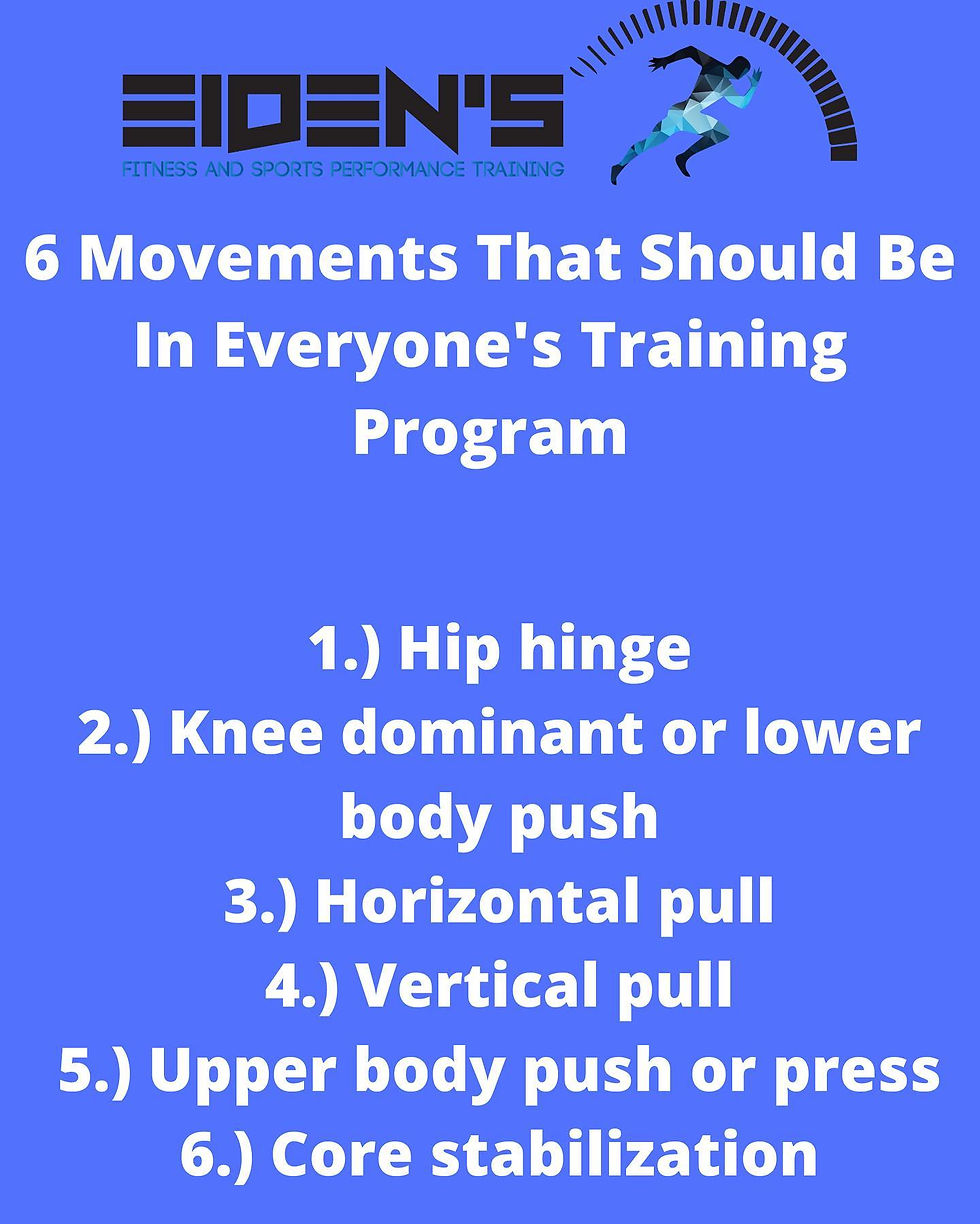6 Movements that should be in everyone's training program
- Dan Eiden

- Jun 28, 2023
- 3 min read

Where do I start? Have you ever walked into a gym and wondered where should I start? With so much equipment, exercise programs and information out there it can be tough for someone to know where to start and what to do when exercising. In an effort to help with that I have come up with 6 movements that should be included in everyone’s training program. You don’t necessarily have to have all 6 in each of your workouts but they should be in your training program. A training program consisting only of these 6 movements would be a complete training program as it covers all the bases by training the entire body.
1. Hip hinge = A hip hinge is a lower body movement that works the posterior chain or backside of your body. It is essentially the movement of bending forward at your waist with minimal knee bend and bringing your hips back forward. It works the body primarily in hip extension with the gluteus and the hamstrings being the major muscles worked while also working the core or abdominal muscles and erector spinae (muscles that extend your back or trunk.) An example of a hip hinge exercise would be a deadlift, hip thrust or a cable pull through.
2. Knee dominant or lower body push = While hip hinge movements primarily work the back side or posterior of the body a knee dominant or lower body push movement primarily works the front side of the body with movement mainly coming at the knee joint. Any major knee dominant movement will also have a significant amount of hip movement as well with some exercises being probably 50/50 as far as how much movement is coming at the knee joint vs the hip joint. A knee dominant lower body push movement primarily works the quadriceps, hamstrings and glutes. An example of a knee dominant lower body movement would be a squat, lunge or step-up.
3. Horizontal pull = A horizontal pull is essentially a rowing movement. This is a movement where you are pulling a weight or load towards your chest or torso horizontally. These movements primarily work the muscles in the middle of the back between your shoulder blades called the scapula retractors (rhomboids and trapezius 2 fibers) as well as the lats (latissimus dorsi), rear shoulders (rear deltoids) and biceps. An example of a horizontal pull would be one arm dumbbell row, inverted row or a barbell row.
4. Vertical pull = A vertical pull is a movement for the back where you are pulling a weight or load vertically down towards you and drawing your shoulder blades down or depressing your scapula. An example of a vertical pull would be a chin up or a lat pulldown. Vertical pulling movements primarily work the lats but also train the trapezius, rear deltoids (shoulders) and biceps among other muscles.
5. Upper body push or pressing movement = An upper body push is basically any pressing movement. This is a movement where you are pushing a weight or load away from your torso. These movements can be a horizontal push (pushing forward) such as a push-up or bench press or a vertical push (pushing overhead) such as an overhead dumbbell press or military press. Upper body pushing movements include exercises such as the bench press, incline press, overhead shoulder press and push-ups . Upper body push movements work primarily the chest, shoulders and triceps but depending on which upper body pushing movement you do which muscles worked can vary some.
6. Core stabilization = Many people think of training the core and think of direct abdominal training exercises like sit ups, crunches and leg raises. While the abdominals can perform trunk flexion (a crunch or sit up motion) and hip flexion (leg raises or reverse crunches) these usually aren’t their primary role. The abdominals and core (by my definition any muscle attaching to the hip) in general work primarily work in a stabilization role. There are 3 main ways they work in that stabilization role. They are anti-extension (front planks and push up holds), anti-rotation (push-up taps, cable and banded chops and anti-rotation band holds) and anti-lateral flexion (unbalanced carries, side planks and half kneeling exercises). When training the core include exercises to train the core including movements working anti-extension, anti-lateral flexion and anti-rotation in your program.
Before performing any exercise or exercise program it is important to consult your doctor before starting.
Thank you for reading my blog article. I hope you found it helpful and informative. If anyone is interested in personal fitness training or sports performance training reach out to me via my email Dan@eidensfitness.com or you can contact me directly at 702-521-6012.
Dan Eiden
B.S., CPT, CSCS
Personal Trainer and Strength and Conditioning Coach
Owner of Eiden’s Fitness and Sports Performance Training
Las Vegas, Nevada



Comments